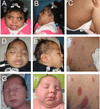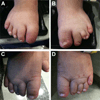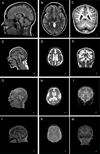The microcephaly-capillary malformation syndrome
- PMID: 21815250
- PMCID: PMC3428374
- DOI: 10.1002/ajmg.a.34118
The microcephaly-capillary malformation syndrome
Abstract
We report on three children from two families with a new pattern recognition malformation syndrome consisting of severe congenital microcephaly (MIC), intractable epilepsy including infantile spasms, and generalized capillary malformations that was first reported recently in this journal [Carter et al. (2011); Am J Med Genet A 155: 301-306]. Two of our reported patients are an affected brother and sister, suggesting this is an autosomal recessive severe congenital MIC syndrome.
Copyright © 2011 Wiley-Liss, Inc.
Figures





Comment in
-
Microcephaly-capillary malformation syndrome: a story of rapid emergence of a new recognizable entity.Am J Med Genet A. 2011 Sep;155A(9):2078-9. doi: 10.1002/ajmg.a.34149. Epub 2011 Aug 10. Am J Med Genet A. 2011. PMID: 21834052 No abstract available.
Similar articles
-
Microcephaly-capillary malformation syndrome: a story of rapid emergence of a new recognizable entity.Am J Med Genet A. 2011 Sep;155A(9):2078-9. doi: 10.1002/ajmg.a.34149. Epub 2011 Aug 10. Am J Med Genet A. 2011. PMID: 21834052 No abstract available.
-
The microcephaly-capillary malformation syndrome in two brothers with novel clinical features.Pediatr Neurol. 2014 Oct;51(4):560-5. doi: 10.1016/j.pediatrneurol.2014.07.006. Epub 2014 Jul 16. Pediatr Neurol. 2014. PMID: 25266620
-
Mutations in STAMBP, encoding a deubiquitinating enzyme, cause microcephaly-capillary malformation syndrome.Nat Genet. 2013 May;45(5):556-62. doi: 10.1038/ng.2602. Epub 2013 Mar 31. Nat Genet. 2013. PMID: 23542699 Free PMC article.
-
Primary hypogonadism, partial alopecia, and Mullerian hypoplasia: report of a third family and review.Am J Med Genet A. 2009 Mar;149A(3):501-4. doi: 10.1002/ajmg.a.32645. Am J Med Genet A. 2009. PMID: 19213036 Review.
-
[Resistant epileptic encephalopathy in a child with microcephalic capillary malformation syndrome].Zh Nevrol Psikhiatr Im S S Korsakova. 2020;120(8):110-116. doi: 10.17116/jnevro2020120081110. Zh Nevrol Psikhiatr Im S S Korsakova. 2020. PMID: 32929933 Review. Russian.
Cited by
-
Latest American and European updates on infantile spasms.Curr Neurol Neurosci Rep. 2013 Mar;13(3):334. doi: 10.1007/s11910-012-0334-z. Curr Neurol Neurosci Rep. 2013. PMID: 23341252 Review.
-
Insights into the mechanism of deubiquitination by JAMM deubiquitinases from cocrystal structures of the enzyme with the substrate and product.Biochemistry. 2014 May 20;53(19):3199-217. doi: 10.1021/bi5003162. Epub 2014 May 9. Biochemistry. 2014. PMID: 24787148 Free PMC article.
-
Mechanism of recruitment and activation of the endosome-associated deubiquitinase AMSH.Biochemistry. 2013 Nov 5;52(44):7818-29. doi: 10.1021/bi401106b. Epub 2013 Oct 23. Biochemistry. 2013. PMID: 24151880 Free PMC article.
-
Novel STAMBP mutations in a Chinese girl with rare symptoms of microcephaly-capillary malformation syndrome and Mowat-Wilson syndrome.Heliyon. 2023 Nov 28;9(12):e22989. doi: 10.1016/j.heliyon.2023.e22989. eCollection 2023 Dec. Heliyon. 2023. PMID: 38058451 Free PMC article.
-
AAV-mediated Stambp gene replacement therapy rescues neurological defects in a mouse model of microcephaly-capillary malformation syndrome.Mol Ther. 2024 Nov 6;32(11):4095-4107. doi: 10.1016/j.ymthe.2024.08.017. Epub 2024 Aug 22. Mol Ther. 2024. PMID: 39169623
References
-
- Ashwal S, Michelson D, Plawner L, Dobyns WB. Practic parameter: Evaluation of the child with microcephaly (an evidence-based review): Report of the quality standards subcommittee of the American Academy of Neurology and the Practice Committee of the Child Neurology Society. Neurology. 2009;73:887–897. - PMC - PubMed
-
- Barkovich AJ, Ferriero DM, Barr RM, Gressens P, Dobyns WB, Truwit CL, Evrard P. Microlissencephaly: A heterogeneous malformation of cortical development. Neuropediatrics. 1998;29:113–119. - PubMed
-
- Basel-Vanagaite L, Dobyns WB. Clinical and brain imaging heterogeneity of severe microcephaly. Pediatr Neurol. 2010;43:7–16. - PubMed
-
- Burns AJ, Navarro JA, Cooner RD. Classification of vascular anomalies and the comprehensive treatment of hemangiomas. Plast Reconstr Surg. 2009;124:69e–81e. - PubMed
-
- Carter MT, Geraghty MT, De La Cruz L, Reichard RR, Boccuto L, Schwartz CE, Clericuzio CL. A new syndrome with multiple capillary malformations, intractable seizures, and brain and limb anomalies. Am J Med Genet A. 2011;155:301–306. - PubMed
Publication types
MeSH terms
Supplementary concepts
Grants and funding
LinkOut - more resources
Full Text Sources
Medical

